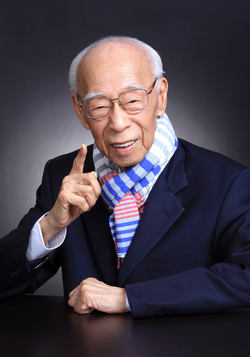Jao Tsung-I facts for kids
Quick facts for kids
Jao Tsung-I
GBM
|
|||||||||||||||||||||||||
|---|---|---|---|---|---|---|---|---|---|---|---|---|---|---|---|---|---|---|---|---|---|---|---|---|---|
 |
|||||||||||||||||||||||||
| Born | 9 August 1917 Xiangqiao, Chaoshan, China
|
||||||||||||||||||||||||
| Died | 6 February 2018 (aged 100) |
||||||||||||||||||||||||
| Resting place | Hong Kong | ||||||||||||||||||||||||
| Other names | Rao Gu'an (Chinese: 饒固庵) | ||||||||||||||||||||||||
| Occupation | Sinologist, historian, palaeographer, calligrapher, painter | ||||||||||||||||||||||||
| Title | Professor of the University of Hong Kong, University of Singapore, Yale University, Academia Sinica, Chinese University of Hong Kong | ||||||||||||||||||||||||
| Spouse(s) | Chen Ruonong | ||||||||||||||||||||||||
| Children | 2 | ||||||||||||||||||||||||
| Parent(s) | Rao E (Chinese: 饒鍔) | ||||||||||||||||||||||||
| Awards | 1982: D.Litt (HKU) 1997: Life Achievement Award (HKADC) 2000: GBM |
||||||||||||||||||||||||
| Chinese name | |||||||||||||||||||||||||
| Traditional Chinese | 饒宗頤 | ||||||||||||||||||||||||
| Simplified Chinese | 饶宗颐 | ||||||||||||||||||||||||
|
|||||||||||||||||||||||||
Jao Tsung-I (also known as Rao Zongyi) was a very famous scholar from Hong Kong. He was born on August 9, 1917, and passed away on February 6, 2018. He was known for many things, like studying Chinese culture (a sinologist), creating beautiful handwriting (a calligrapher), being a historian, and a painter.
Jao Tsung-I was a very talented person who studied many different subjects. These included history, old artifacts (archaeology), ancient writings (epigraphy), folk stories, religions, art, music, and literature. Over his long career of more than 80 years, he wrote over 100 books and about 1,000 articles!
Many people thought Jao Tsung-I and Ji Xianlin were China's two greatest scholars. China's Premier Li Keqiang even called Jao the "pride of Hong Kong." Jao received many awards, including the Grand Bauhinia Medal. This is the highest honor given by the Hong Kong government. Several places are named after him, like the Jao Tsung-I Petite Ecole at the University of Hong Kong. There is also the Jao Studies Foundation and the Jao Tsung-I Academy in Kowloon.
Contents
Early Life and Learning
Jao Tsung-I was born in 1917 in Chao'an, which is now Xiangqiao. His family was from the Teochew area and had Hakka roots. They were known for their love of learning.
He also used other names like Gu'an and Bolian, and an art name, Xuantang. Jao learned most of what he knew at home and by teaching himself. When he was only 14, he wrote a book called The Scholastic Journals of Gu Tinglin.
Jao Tsung-I's Career
Before moving to Hong Kong in 1949, Jao taught at several colleges in mainland China. After that, he taught at many famous universities around the world. These included the University of Hong Kong and the National University of Singapore. He also taught at Yale University in the United States.
He was also an honorary professor at top Chinese universities. These included Peking University, Fudan University, and Nanjing University.
Academic Research and Discoveries
Jao was a very busy and productive scholar. His research covered many areas of human knowledge. He studied oracle bones, which are ancient writings on animal bones or turtle shells. He also explored archaeology, which is the study of human history through digging up old sites.
He also studied epigraphy, which is the study of ancient inscriptions. His work included folk stories, religions, art history, and musicology (the study of music). Jao even learned cuneiform, an ancient writing system. He spent ten years translating an ancient Babylonian story called Enūma Eliš into Chinese. This helped fill a big gap in China's knowledge of ancient Babylon.
In 1959, he published a major book about oracle bone diviners. This book won him an important award from France in 1962. In 2000, he received the Grand Bauhinia Medal. This is the highest honor given by the Hong Kong government.
Artistic Talents
Besides his academic work, Jao Tsung-I was also a famous calligrapher and painter. He even created his own unique style of calligraphy. His special calligraphic art installation called "The Wisdom Path" is a famous landmark in Ngong Ping, Hong Kong. He was also a master at playing the guqin, an ancient Chinese musical instrument.
In August 2017, the Hongkong Post released a set of six special stamps. These stamps featured Jao's beautiful paintings and calligraphy.
Passing Away
Jao Tsung-I passed away on February 6, 2018. He was 100 years old (or 101 by East Asian age reckoning).
See also
 In Spanish: Jao Tsung-I para niños
In Spanish: Jao Tsung-I para niños
- Jao Tsung-I Academy

